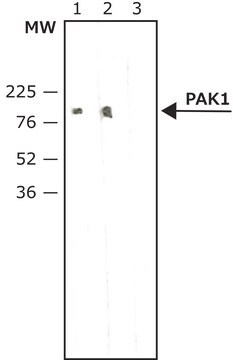MABF2073
Anti-Rabies Virus CVS-11 Antibody, clone 509-6
clone 509-6, from mouse
Sinonimo/i:
Glycoprotein, Glycoprotein Rabies virus, Rabies virus strain CVS-11
About This Item
Prodotti consigliati
Origine biologica
mouse
Livello qualitativo
Forma dell’anticorpo
purified immunoglobulin
Tipo di anticorpo
primary antibodies
Clone
509-6, monoclonal
Reattività contro le specie
rabies virus
Reattività contro le specie (prevista in base all’omologia)
all
Confezionamento
antibody small pack of 25 μg
tecniche
ELISA: suitable
flow cytometry: suitable
neutralization: suitable
Isotipo
IgG2aκ
N° accesso UniProt
Condizioni di spedizione
ambient
modifica post-traduzionali bersaglio
unmodified
Descrizione generale
Specificità
Immunogeno
Applicazioni
ELISA Analysis: A representative lot detected Rabies Virus in ELISA applications (Marissen, W.E., et. al. (2005). J Virol. 79(8):4672-8).
Fluorescence Activated Cell Sorting (FACS) Analysis: A representative lot detected Rabies Virus in Fluorescence Activated Cell Sorting (FACS) applications (Marissen, W.E., et. al. (2005). J Virol. 79(8):4672-8).
Inflammation & Immunology
Qualità
Flow Cytometry Analysis: 1 µg of this antibody detected glycoprotein of Rabies virus in one million L929 cells expressing the rabies protein.
Descrizione del bersaglio
Stato fisico
Stoccaggio e stabilità
Altre note
Esclusione di responsabilità
Non trovi il prodotto giusto?
Prova il nostro Motore di ricerca dei prodotti.
Codice della classe di stoccaggio
12 - Non Combustible Liquids
Classe di pericolosità dell'acqua (WGK)
WGK 2
Punto d’infiammabilità (°F)
Not applicable
Punto d’infiammabilità (°C)
Not applicable
Certificati d'analisi (COA)
Cerca il Certificati d'analisi (COA) digitando il numero di lotto/batch corrispondente. I numeri di lotto o di batch sono stampati sull'etichetta dei prodotti dopo la parola ‘Lotto’ o ‘Batch’.
Possiedi già questo prodotto?
I documenti relativi ai prodotti acquistati recentemente sono disponibili nell’Archivio dei documenti.
Il team dei nostri ricercatori vanta grande esperienza in tutte le aree della ricerca quali Life Science, scienza dei materiali, sintesi chimica, cromatografia, discipline analitiche, ecc..
Contatta l'Assistenza Tecnica.